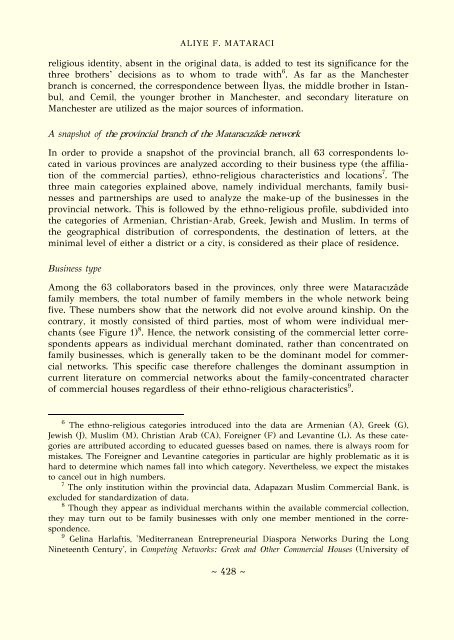Create successful ePaper yourself
Turn your PDF publications into a flip-book with our unique Google optimized e-Paper software.
ALIYE F. MATARACI<br />
religious identity, absent in the original data, is added to test its significance for the<br />
three brothers’ decisions as to whom to trade with 6 . As far as the Manchester<br />
branch is concerned, the correspondence between İlyas, the middle brother in Istanbul,<br />
and Cemil, the younger brother in Manchester, and secondary literature on<br />
Manchester are utilized as the major sources of information.<br />
A snapshot of the provincial branch of the Mataracızâde network<br />
In order to provide a snapshot of the provincial branch, all 63 correspondents located<br />
in various provinces are analyzed according to their business type (the affiliation<br />
of the commercial parties), ethno-religious characteristics and locations 7 . The<br />
three main categories explained above, namely individual merchants, family businesses<br />
and partnerships are used to analyze the make-up of the businesses in the<br />
provincial network. This is followed by the ethno-religious profile, subdivided into<br />
the categories of Armenian, Christian-Arab, Greek, Jewish and Muslim. In terms of<br />
the geographical distribution of correspondents, the destination of letters, at the<br />
minimal level of either a district or a city, is considered as their place of residence.<br />
Business type<br />
Among the 63 collaborators based in the provinces, only three were Mataracızâde<br />
family members, the total number of family members in the whole network being<br />
five. These numbers show that the network did not evolve around kinship. On the<br />
contrary, it mostly consisted of third parties, most of whom were individual merchants<br />
(see Figure 1) 8 . Hence, the network consisting of the commercial letter correspondents<br />
appears as individual merchant dominated, rather than concentrated on<br />
family businesses, which is generally taken to be the dominant model for commercial<br />
networks. This specific case therefore challenges the dominant assumption in<br />
current literature on commercial networks about the family-concentrated character<br />
of commercial houses regardless of their ethno-religious characteristics 9 .<br />
6 The ethno-religious categories introduced into the data are Armenian (A), Greek (G),<br />
Jewish (J), Muslim (M), Christian Arab (CA), Foreigner (F) and Levantine (L). As these categories<br />
are attributed according to educated guesses based on names, there is always room for<br />
mistakes. The Foreigner and Levantine categories in particular are highly problematic as it is<br />
hard to determine which names fall into which category. Nevertheless, we expect the mistakes<br />
to cancel out in high numbers.<br />
7 The only institution within the provincial data, Adapazarı Muslim Commercial Bank, is<br />
excluded for standardization of data.<br />
8 Though they appear as individual merchants within the available commercial collection,<br />
they may turn out to be family businesses with only one member mentioned in the correspondence.<br />
9 Gelina Harlaftis, 'Mediterranean Entrepreneurial Diaspora Networks During the Long<br />
Nineteenth Century', in Competing Networks: Greek and Other Commercial Houses (University of<br />
~ 428 ~



